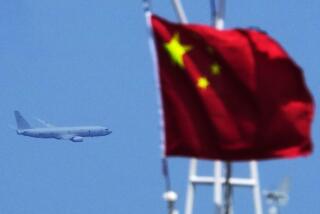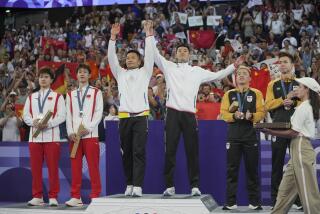Long-Struggling Opposition Finally Comes Into Its Own
TAIPEI, Taiwan — The devastating electoral defeat of Taiwan’s ruling Kuomintang, or Nationalist Party, represents a historic turning point for this island of 22 million people and for China.
Not since the Japanese relinquished control of Taiwan at the end of World War II has anyone from outside the Kuomintang, or KMT, held power here. The party’s rule has been part of the fabric of daily life for more than half a century.
Even Taiwan’s currency still carries the image of Generalissimo Chiang Kai-shek, who brought the KMT here in the last days of the civil war he lost on the mainland.
Now, the KMT is turning over the presidency to a political entity, the Democratic Progressive Party, which the KMT didn’t even permit to organize until 14 years ago.
At the time, in 1986, the KMT believed that it could continue to hold on to power in Taiwan for decades--in the fashion of Japan’s ruling Liberal Democratic Party, which in those days allowed other parties to participate in elections, but not to win.
The Democratic Progressives arose as the political vehicle for native Taiwanese, who make up 80% of the island’s population and who were, until the late 1980s, largely excluded from the top ranks of the KMT.
In some ways, Chen Shui-bian’s victory Saturday was comparable to the victories of Kim Dae Jung in South Korea and Corazon Aquino in the Philippines. In each case, Asian opposition movements challenged authoritarian regimes for many years until eventually, with the help of elections and political liberalization, they came to power themselves.
In other ways, however, Chen’s remarkable victory can’t be compared with what has happened anywhere else, because of the huge, looming presence of China in Taiwan’s political life.
The election of an opposition candidate ruptures, at least for the time being, nearly eight decades of on-again, off-again ties between the Chinese Communist Party and the KMT. Those ties involve so much conflict, manipulation and intimacy that a psychologist might describe the two groups as codependent.
In the early decades of the 20th century, the men who led the KMT and the Chinese Communist Party knew one another well. Many of them went to school with one another at the Huangpu Military Academy in southern China.
When Chiang ruled mainland China, the Communists occasionally formed “united fronts” with the KMT--that is, coalitions of convenience--designed sometimes to fight the Japanese but also to give both sides time to regroup and regain strength in their continuing civil war.
Eventually, the “united front” campaigns would break down, and the two sets of antagonists would go back to killing one another again.
Rivalry Continued Despite Distance
When the KMT fled to Taiwan, its rivalry with the Communists continued for decades. In Taiwan, pictures of such Communist leaders as Mao Tse-tung and Chou En-lai were regularly stamped with the word “bandits.”
And yet, despite the enmity, China’s Communists also for years counted on the KMT as its best hope for reunifying Taiwan with the mainland.
China’s logic was simple: Many of the KMT leaders had fled to Taiwan from the mainland and eventually, Beijing hoped, the KMT would want to make a deal enabling them to return home.
But this calculation began to erode in the mid-1980s. Oddly enough, the chain of events that culminated with Saturday’s Democratic Progressive victory began with a Communist Party triumph: In 1979, the United States finally granted diplomatic recognition to the People’s Republic of China and cut off ties with the Nationalists’ Republic of China on Taiwan.
In the early ‘80s, Taiwan thus found itself out in the cold. In the U.S., it had little public support because the KMT was repressive and undemocratic. Taiwanese intelligence officials were caught and eventually convicted of murdering a Taiwanese writer on U.S. soil.
Finally, in 1986, President Chiang Ching-kuo, Chiang Kai-shek’s son, decided to open up Taiwan’s political life. He permitted the Democratic Progressives to take part in elections. At the same time, he also groomed a native Taiwanese leader, Lee Teng-hui, to be his successor.
Tiananmen Gives Taiwan a Boost
Both actions served to revive Taiwan’s flagging support in the United States. After the 1989 Tiananmen Square crackdown in Beijing, Taiwan could legitimately tell Congress that it was democratizing, while China certainly was not.
Lee came to power after the younger Chiang’s death in 1988. That was, by itself, a significant change: For the first time, Taiwan’s president did not come from mainland China. The old KMT-Communist ties were beginning to fray.
And indeed, over the last 12 years, Lee has given Beijing fits. He has carried out a series of initiatives to establish Taiwan as an independent political entity, culminating in his insistence last summer that Taiwan should have “special state-to-state relations” with China.
On the mainland early this year, several Chinese scholars and officials said they felt that any of the three leading candidates in Taiwan’s election would be an improvement over their nemesis, Lee.
Yet it turned out that the curious historical ties between the Communists and the Kuomintang outweighed China’s irritation with Lee.
In the last weeks of the presidential campaign, China was all but begging Taiwanese voters to elect Lee’s designated successor, Lien Chan, the Nationalists’ candidate.
It was the ultimate irony. For decades when the KMT ruled the mainland the Communists had portrayed it (often with good reason) as corrupt.
This year, in Taiwan’s election campaign, the main issue Chen’s forces used against the KMT was, once again, corruption. But this time, China’s Communist regime was rooting for the KMT.
Now, China will have to begin a new history with a new political force whose leaders have few, if any, personal ties to the mainland.
More to Read
Sign up for Essential California
The most important California stories and recommendations in your inbox every morning.
You may occasionally receive promotional content from the Los Angeles Times.










